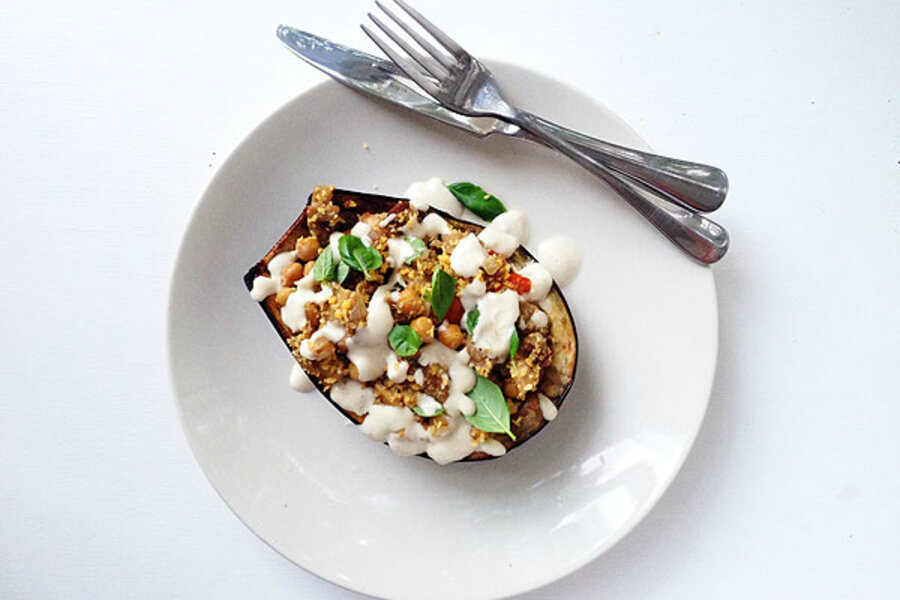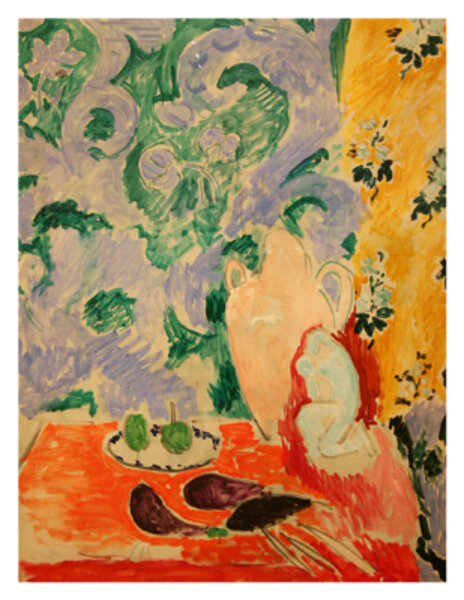Stuffed eggplant, inspired by Henri Matisse
Loading...
The 1911 painting "Still Life with Aubergines" by Henri Matisse exemplifies the characteristics of the Fauvist movement with the wild brushstrokes and incongruent colors. The painting was completed during a period of flux in Matisse’s oeuvre. During this time in his career he was influenced by travel to Algeria and a major exhibition of Islamic Art in Munich.
The resulting composition incorporates the highly decorative ornamentation typically found in Islamic Art into the vivid swirling shapes of the wallpaper. The simplified figure in the sculpture reflects the time in Algeria where he studied primitive art.
The recipe below features the aubergine (eggplant) depicted by Matisse while including North African/Middle Eastern ingredients: tahini, couscous and chickpeas.
Stuffed Eggplant
Adapted from Diggin up the Dirt
Yield: 4 servings
2 eggplants
3 tablespoons olive oil, divided
1 onion, chopped
4 cloves garlic, minced
12 cherry tomatoes, halved
1 can chickpeas, drained
1/2 cup uncooked couscous
1/2 cup boiling water
1/4 cup tahini
1 lemon
1/4 cup water
Pinch of salt and pepper
Handful of basil leaves
1. Cover a large baking tray with parchment paper and preheat the oven to 425 degrees F./ 220 degrees C. Wash the eggplant and cut off the top. Scoop out the insides of the eggplants (cut into small pieces and reserve for later), leaving about 1 inch of the flesh still attached to the skin. Drizzle over 1 tablespoon of the olive oil and arrange the halved eggplants cut-side down on the baking tray. Slide into the hot oven and cook for 30 minutes.
2. Heat the remaining olive oil in a large frying pan and begin cooking the chopped onion. After 5 minutes, add 3 of the minced garlic cloves and sauté for another 2 mintues. Add the reserved eggplant and continue to cook for a further 5 minutes. Add the tomato and chickpeas and continue to cook until the eggplant is soft, around 10 minutes.
3. Meanwhile, combine the couscous and boiling water in a small bowl. Cover with a lid and set aside for 5 minutes. Once the water has been absorbed, fluff with a fork.
4. In another small bowl, combine the remaining clove of minced garlic, tahini, juice of half of a lemon, 1/4 cup of water, salt and pepper. Mix well and set aside.
5. When the eggplants in the oven have finished cooking, turn them onto a serving platter. Add the couscous into the chickpea/eggplant mixture in the frying pan and stir well. Squeeze over the juice of the remaining half of lemon. Scoop the mixture into the hollowed-out, roasted eggplants and scatter over the basil leaves. Drizzle the tahini sauce and serve immediately.






